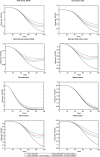A cost-effectiveness analysis of adult human papillomavirus vaccination strategies in Italy
- PMID: 40094352
- PMCID: PMC11917173
- DOI: 10.1080/21645515.2025.2474891
A cost-effectiveness analysis of adult human papillomavirus vaccination strategies in Italy
Abstract
Vaccination can reduce the public health and economic burden of human papillomavirus (HPV)-associated diseases. In 2023, the Italian national immunization program (NIP) was updated to include HPV vaccination of females ≤26 and males ≤18 years. However, the cost-effectiveness of this update along with proposals to include additional cohorts is unknown. This study evaluates the cost-effectiveness of different HPV vaccination strategies in Italy over a 100-year period, using a published dynamic transmission model with Italy-specific input data. We modeled vaccination of the primary cohort (11 years of age) for 100 years, alone and supplemented with vaccination of additional cohorts for 5-100 years. We found that vaccination of the primary adolescent cohort resulted in substantial, sustained decreases in the incidence and mortality rates of all HPV-related cancers, but smaller, transient decreases in genital warts and recurrent respiratory papillomatosis. Adding supplementary vaccination of additional cohorts for 5-10 years had minor additional public health benefits, while continuing any of the modeled supplementary vaccination strategies for 100 years resulted in more substantial incremental benefits. For example, implementing the 2023-2025 NIP strategy for 100 years averted an additional 21,495 cases of cervical cancer compared to vaccination of the primary cohort alone. All supplementary vaccination strategies that were continued for 10 or 100 years were cost-effective compared to vaccination of the primary cohort alone at a willingness-to-pay threshold of €40,000 per quality-adjusted life year (QALY) gained. The benefits deriving from vaccinating additional cohorts should be considered when developing and updating NIPs.
Keywords: HPV immunization; Human papillomavirus; cost-effectiveness; economic analysis; health economics; men; women.
Plain language summary
The human papillomavirus (HPV) is a common sexually transmitted infection, and persistent infections with some HPV genotypes can cause diseases including anogenital and head and neck cancers, genital warts, and recurrent respiratory papillomatosis. Three HPV vaccines have been approved by the European Medicines Agency, and the introduction of HPV vaccination in Italy has been associated with a reduced public health and economic burden of HPV-related diseases. However, HPV vaccine uptake among the primary cohort has been well below the target, making HPV-related diseases a major source of morbidity, mortality, and health care costs in Italy. In this study, we modeled the public health and economic impacts of various supplementary HPV vaccination strategies in Italy over a 100-year period compared to vaccination of the primary adolescent cohort (11 years of age) alone, from the health care system perspective. The analysis incorporates all diseases attributable to HPV genotypes included in the 9vHPV vaccine, in both sexes, and compares supplementary vaccination strategies that include different age groups and that run for different durations. We found that vaccination of the primary adolescent cohort over a 100-year period resulted in substantial, sustained reductions in the incidence and mortality rates of all HPV-related cancers compared to no vaccination, but smaller, transient decreases in genital warts and recurrent respiratory papillomatosis. Adding supplementary vaccination of additional cohorts for 5- or 10-year durations had minor additional public health benefits, while continuing any of the modeled supplementary vaccination strategies for 100 years resulted in more substantial and sustained benefits compared to vaccination of the primary cohort alone. The incremental benefits of 100-year supplementary vaccination programs were particularly large for anal, head and neck, penile, and vulvar cancers; genital warts; and RRP. These benefits deriving from additional targets of vaccination programs could be taken into account when considering vaccination strategies. The implementation of policies strategies including additional cohorts should be performed together with awareness campaigns, routine vaccination reminders, and possible government subsidies to accelerate HPV elimination.
Conflict of interest statement
AC, CP, and FS are employees of Merck Sharp & Dohme LLC, a subsidiary of Merck & Co., Inc., Rahway, NJ, USA and may own restricted stock units and/or stock options in Merck & Co., Inc., Rahway, NJ, USA. CS and SB have no conflicts of interest. The study was funded by a research grant from MSD Italy with PIN S.c.r.l. (Polo Universitario di Prato available online:
Figures



References
-
- HPV Information Centre . Human papillomavirus and related diseases report - Italy. 2023. [accessed 2024 Feb 26]. https://hpvcentre.net/statistics/reports/ITA.pdf.
-
- Varga S, Wang X, Luttropp K, Morais E, Walia A, Pimpin L, Eriksson J, Kothari S. Global burden of HPV-related cancers in men: a systematic literature review. J Clin Oncol. 2019;37(15_suppl):e13108. doi: 10.1200/JCO.2019.37.15_suppl.e13108. - DOI
MeSH terms
Substances
LinkOut - more resources
Full Text Sources
Other Literature Sources
Medical
